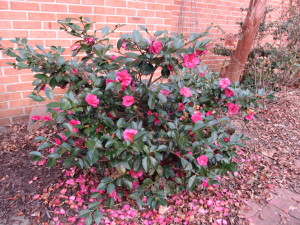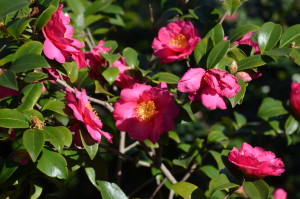A short list of early blooming Sasanqua camellias possess the ability to do grow well in zone 6 areas. In my opinion, the zone 7 cultivar ‘Shishigashira’ steps to the head of the class. It is a November bloomer that has proven to be exceptionally cold hardy dwarf variety.
The good folks at Cam Too, a camellia wholesale nursery in Greensboro, NC, highly recommends these hardy cultivars: ‘Kanjiro’, ‘Hiryu’, ‘Yoi Machi’, ‘Crimson Candles’ and ‘Korean Fire’. All are (Camellia sasanqua) bloodline except Korean Fire (C. japonica) .
Their vegetative and floral hardiness is excellent–even following nights in the low 20’s, the open flowers still held their color. Plants exhibit upright branching and will be full in good light exposure. all would be cold hardy to zone 6-b and would flower for you.
Shishigashira – hot pink semi-double flowers; low and wide spreading habit.
Kanjiro – pink semi-double bloom edged in red with golden stamens and a slight fragrance; dense semi-weeping habit; glossy, dark green foliage.
Hiryu – deep crimson red, rose-form, double flowers in early fall; compact shrub, and more sun-loving than most camellias.
Yoi Machi – vigorous grower with white petalled flowers with pale pink margins; it blooms from late fall into spring.
Crimson Candles – vigorous grower and disease resistant; small bright rose-red single flowers in early fall; new foliage is bronze-red.
Korean Fire – single red flowers which start opening in late February thru April; reportedly survived -23 °F in southeast Pennsylvania, unusual for C. japonica.
Simple growing tips: camellia culture is similar to that of rhododendrons or azaleas. They prefer a mildly acidic well-drained, compost rich soil. Grow them in full morning sunlight in zone 6 and 7-a and in partial all day sun in zone 7b and points further south. Protect camellias against prevailing winds, particularly in the winter months. Irrigate new plants in their first year, but do not overwater. Mulch with an acidic type leaf mold from oak leaves or pine bark chips or nuggets; mulch feeds and protect roots from drastic heat and droughty soils.



 Posted in
Posted in 
